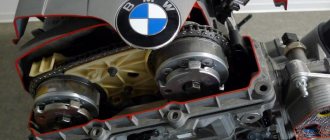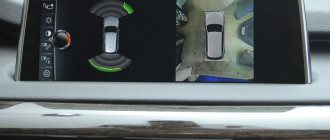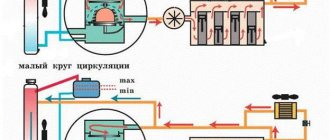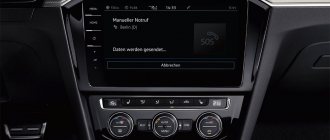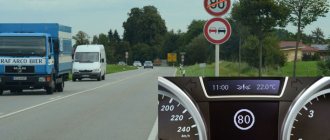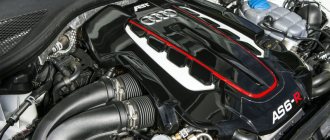After the first anti-lock braking systems (ABS) appeared in cars, which worked on the simplest principle of releasing hydraulic pressure at the first sign of tire slipping, it became clear that the efficiency of the system needed to be increased. The price to pay for the stability of the car during braking was: lengthening the braking distance and several other disadvantages.
With the development of technology, multi-channel systems with additional intelligence have appeared, making it possible to predict the situation and more accurately control braking, distributing pressure to each wheel in a strictly dosed manner, taking into account its position and operating conditions.
The design received the abbreviation EBD, that is, Electronic Brakeforce Distribution, braking force distribution.
Why is there an EBD system in a car?
The operating principle of conventional ABS from its first incarnations implies the presence of a single control channel. Each wheel has a rotation speed sensor, the readings of which in the form of the frequency of electrical impulses are transmitted via cables to a common electronic unit, where they are encoded into digital information and processed by a microcomputer.
The device analyzes all received data and determines the speed of the vehicle. Having noticed the beginning of braking, he begins to evaluate the deviations in the speed of rotation of individual wheels, thus recording the beginning of their slipping due to exceeding the limit of adhesion to the road.
Since the efficiency of deceleration in the event of a transition to sliding is greatly deteriorated, which can additionally be noted by the signals from the vehicle’s linear acceleration sensor, a decision is made to regulate the pressure in the brake line.
Working principle of EBD
Electronics, using sensors, determines the change in the rotation speed of a specific wheel or pair of wheels, which occurs when the car hits a difficult surface, for example, an area with ice or water. By analyzing data from sensors, the EBD system determines the degree of adhesion to the road surface of each of the wheels and makes a decision on the distribution of braking force. After this, the valves receive a command to strengthen or weaken the operation of the brake discs. After balancing the braking forces, EBD stops working and allows the driver to freely maneuver and change the trajectory.
Operating principle of the brake force distribution system
EBD, unlike ABS, works even before sliding begins. The system has data on axle loading obtained during operation and is able to manage forces.
For example, if the bulk of the car's weight falls on the front axle, that is, the rear of the car is not loaded, then the natural effect of dynamic redistribution of the car's weight forward during braking will be aggravated by the light rear axle.
In emergency braking conditions on a slippery surface, the rear wheels will begin to lock too early, the result will be a decrease in pressure in the entire system and the capabilities of the well-loaded front wheels will not be realized. The braking distance will rush to infinity.
An even worse situation can arise when turning on a rough road. Drivers of old cars that were not equipped with brake electronics were even taught that braking in a turn is categorically not recommended, and they could notice for themselves what happens when the wheels bounce on bumps while pressing the brake pedal and remember for the rest of their lives.
Anti-lock braking systems have made driving much easier; now braking during a turn has become not only possible, but also a recommended action.
Related article: What is athermal glazing in a car
In difficult conditions, an inexperienced driver only had to press the brake with maximum force and then adjust the car only with the steering wheel; the necessary grip would be provided by the automatic system.
The role of EBD in all these cases was to minimize braking distance. If the front wheels have a reserve of grip during normal braking, when the rear wheels are already locked and subject to ABS service, then it will be very irrational to relieve pressure from them too.
On the contrary, you need to add force to the front axle, not dump it evenly from all wheels, but redistribute it. Four-channel systems are capable of this, and the corresponding electronic unit control program has become the basis of EBD.
It's the same when turning. The inner wheels can be so unloaded due to centrifugal force that they literally rise into the air. Naturally, when you try to brake, they will instantly lock up, since the traction force is close to zero.
ABS would react to the situation by completely stopping braking, that is, it would act like an old-school driver.
But EBD is much smarter, it can not only prevent blocking of the unloaded wheels on the inner side of the car relative to the turn, but also increase the pressure in the brake cylinders of the outer, loaded side.
You need to know this: How to check the Mass Air Flow Sensor (MAF)
The car will begin to slow down quite effectively, which in situations where the speed is exceeded in a turn can save both the vehicle and the driver and passengers.
There are other situations where predictive split control can help stop a vehicle quickly:
- braking on a road with an uneven surface, when the coefficient of adhesion for all wheels varies greatly, such as getting into puddles, local dirt or ice spots;
- the car begins to rotate, some wheels are still capable of braking, while others are already sliding and uncontrollable;
- short-term wheel bounces on uneven surfaces;
- malfunction or contamination in the brake system when there are differences in the effectiveness of the wheel brake mechanisms.
The principle of driver assistance from EBD is precisely that it adds the previously inaccessible function of separate wheel maintenance during braking.
This is interesting: Which is better all-wheel drive, front or rear?
If earlier it could, to some extent, imitate the operation of ABS by intermittently pressing the pedal, then control of the brake balance was only available in certain racing series, where the most experienced pilots drive complex and expensive cars.
With the advent of EBD, this has become available to everyone, without any special skills or knowledge.
What does EBD do? Why another bells and whistles for ABS and ESP?
Stas [stas90]
06.11.2018,
It seems that you can talk about braking systems endlessly. As soon as one system is tested, it is implemented on most car brands; to help it, manufacturers rush to create another braking program, which, according to them, greatly simplifies the braking mode and makes it easier to drive a car in difficult road conditions. Indeed, it is difficult to foresee all the subtleties of emergency braking and the behavior of a car on different road surfaces. Time has shown the following disadvantages of simple ABS systems:
- inadequate behavior of the braking system on a road with an uneven surface (one wheel is in mud, the second is in sand, the third is in a hole, and the fourth is on ice, a typical situation in Russian open spaces);
- unpredictable behavior when braking on ice or sleet;
- displacement of the braking distance when turning when one of the wheel groups is unloaded;
- During emergency braking on a straight section of the road, the rear wheels are greatly unloaded, and even with a small force on the brake pads they can be blocked and, therefore, uncontrollable.
The EBD system was originally intended only to reduce braking distance for the last of these situations, especially when the vehicle is laden. According to kinematics, during sharp braking due to inertia, the rear wheels are slightly unloaded. Theoretically, they can even get off the ground, like in motorcycle videos. Almost the entire load falls on the front wheels. To evenly distribute the load on the brake axles, the EBD system was developed. It is designed to reduce braking distance:
What complements EBD to ABS?
The ABS system, developed in the 80s, monitored the presence of a locking moment of one of the wheels. At the same time, the software and hardware did not calculate at what speed the other wheels rotate or what their grip mode is. With the advent of smarter microprocessor control, the signal from each wheel speed sensor is first converted into a digital signal (that is, into rectangular pulses of standard amplitude encoding the frequency). The digital signal is processed in a microprocessor using a specific mathematical algorithm. In this case, various situations can be taken into account mathematically. For example, if the rotation speed of the front wheel is significantly less than all the others, it is possible that it is “hovering” above the road. If only one of the rear wheels is locked, it is most likely on the sandy side of the road. You can program a large number of possible situations and the “manner” of braking of each wheel in a specific case.
The main idea of EBD is to teach each wheel to brake according to its own scenario, depending on the situation. This is why the system is called Brake Distribution.
EBD system:
- as a result of analyzing sensor signals, the ABS generates distributed braking forces for each circuit separately;
- helps the exchange rate stability system by distributing braking forces across the axles;
- reduces the braking distance of the car, especially when loaded;
- controls braking forces when exposed to longitudinal and lateral loads.
What works on the EBD system
Like all braking assistance systems, the EBD system shamelessly exploits the standard ABS system, namely:
- Wheel speed sensors.
- ABS control unit, amplitude-to-digital converters, input circuits. The microprocessor that processes the signal can be installed separately.
- The ABS hydraulic unit can also be equipped with special EBD valves.
- Acceleration sensor (G-sensor).
The technical design of EBD is based on ABS, its circuit has a standard form.
Causes and symptoms of system malfunction, elimination
The causes of EBD system malfunction may be:
- microprocessor control malfunction;
- violation of firmware;
- failure of one of the wheel speed sensors, violation of electrical wiring, working gap;
- hydraulic unit valve failure;
- ABS unit pump malfunction;
- G-sensor failure.
Typically, an EBD fault is indicated simultaneously with an ABS fault. Signs of such a malfunction are, first of all, the corresponding lights coming on while the car is moving. After a software reset of the error, the warning lights on the dashboard may disappear for a while. But it appears again after a few kilometers. Therefore, you cannot trust would-be diagnosticians who reset the error and assure that the problem has been fixed. Before resetting the error, you must write down its code, decipher it and eliminate it. If the error is the failure or loss of signals from the wheel rotation sensors, it is necessary to check the wiring from the sensor to the ABS unit, the size and clogging of the sensor working gap before changing the sensor. The sensor must be tested in “diode” mode with a multimeter in at least one direction. The sensor connectors for the front wheels are located in the area of the side members, the rear wheels are located near or under the rear seats.
After eliminating the errors, it is possible that the system may immediately become inoperable. EBD adaptation required. It is different for each car, but usually includes several sequential braking. It is often enough to drive onto the highway and apply several brakes at medium speed until the vehicle comes to a complete stop.
Advantages and disadvantages
The advantages of the system include the following factors:
- EBD was originally developed to control emergency braking when the vehicle is loaded, so when working on small commercial vehicles it is simply necessary;
- the system increases the effectiveness of the main ABS;
- EBD extends the life of rear tires, brake pads;
- a significant reduction in the braking distance of a loaded vehicle.
Minuses:
- in many cases the system is an unnecessary addition to other braking programs; if the car is driven without load, EBD can be on an endless paid holiday;
- like any system, EBD requires maintenance; if its fault icon lights up, the problem will have to be solved, even if the use of the system is not essential;
- There are cases of inadequate operation of the system.
Currently, approximately 50% of vehicles are equipped with EBD. It is significant that this percentage has not increased in recent years.
System design
Regulating the braking force separately on all wheels will first of all require the use of a multi-channel anti-lock braking system.
This is where the EBD composition is formed:
- individual sensors for each wheel;
- inlet and outlet valves that open fluid pressure on the working cylinders, fixing it unchanged or relieving the force;
- an electric brake fluid pump capable of quickly changing the pressure in the system;
- hydraulic pressure accumulator optimizing pump operation;
- a special control program, which, in fact, forms the basis of EBD, distinguishing it from four-channel ABS;
- additional sensors that expand the capabilities of the system; they can be part of on-board electronics at a higher level than those responsible only for the brakes.
The exact algorithms for the operation of EBD from different manufacturers are not advertised for obvious reasons, but it is possible to identify general algorithms that form the EBD model in the program memory of its computer.
There is a certain threshold condition beyond which the EBD comes to life from standby mode and engages the brakes. This condition is formed based on the results of continuous analysis of information received from sensors.
FYI: What is a brake caliper and how does it work?
As soon as the unit realizes that there is a possibility of wheel blocking, it goes into pressure fixing mode, as a result of which both valves on each wheel close and the pressure stabilizes.
Next, the development of the situation is assessed and commands are given to open or close individual valves, the pressure increases or decreases, pulse control of braking occurs on the verge of blocking, that is, the most effective.
What elements work in the system
EBD is no exception and is actively involved in the operation of the default ABS system:
• sensors that control the rotation of each wheel;
• input circuit, ABS main control unit, digital indicator converters. Sometimes a microprocessor is installed separately, which is responsible for signal processing and conversion;
• in some cases, the standard system is additionally equipped with special EBD valves;
• use of touch G-sensors.
To organize technical equipment, ABS is used according to a standard scheme.
Symptoms of EBD malfunction
Any failure of the system results in poor braking performance in an emergency, which is unlikely to be noticed by the driver. Therefore, the only sign of a malfunction is the warning light on the dashboard coming on.
The appearance of this signal requires immediate diagnosis with a special scanner, identifying error codes and troubleshooting.
The system is very reliable, so the most common malfunction is the failure of the wheel sensors. This is due to their work in difficult conditions of humidity and pollution.
We recommend: How to install a rear view camera on a car (connection diagram)
Corrosion and mechanical failures lead to signal loss, which will be immediately noticed by the electronic unit and a warning lamp will appear. The check is quite simple for diagnosis; repairs come down to replacing the sensor or revising its wiring.


